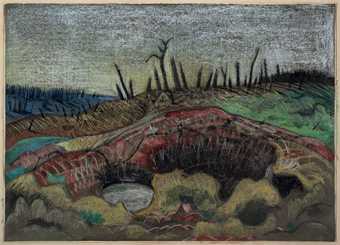'Shell holes in villages are full of elementary force. Everything around them seems subject to the dynamic of these violent, symmetrical craters. They are the eye sockets of the earth, and circling around them are their painfully fantastical lines. Those aren't houses anymore, no one seriously believes that. They are living creatures, a particular species with its own laws and living conditions. They are sheer holes with stones around them, or sheer skeletons. It is a strange, rare beauty that speaks here.'1
– Postcard from Otto Dix to his friend Helene Jakob, Aubérive, France, 22 June 1916
'Oh these wonderful trenches at night, at dawn, at sundown. Shall I ever lose the puncture they have made in my mind? Imagine a wide landscape flat and scantily wooded and what trees remain blasted and torn, naked and scarred and riddled. The ground for miles around furrowed into trenches, pitted with yawning holes in which the water lies still and cold or heaped with mounds of earth, tangles of rusty wire, tin plates, stakes, sandbags and all the refuse of war.'2
– Letter from Paul Nash to his wife Margaret, Ypres, Belgium, 6 April 1917
Notes
1. Ralph Ubl, Prehistoric Future: Max Ernst and the Return of Painting Between the Wars, translated by Elizabeth Tucker, University of Chicago Press, Chicago 2013, p.1552. Tate archive, TGA 8313/1/1/141


